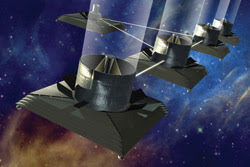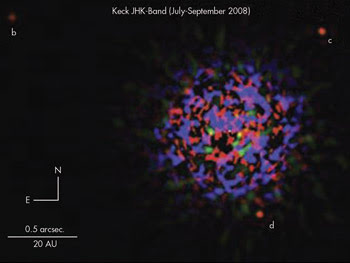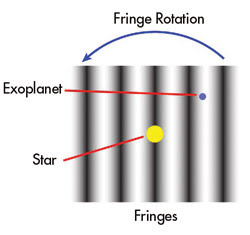Claude Thomas Walker and Dave H asenauer, Optical Research Associates
Optical Research Associates gratefully acknowledges the assistance of Dr. Wesley Traub and Michael Devirian of Jet Propulsion Laboratory, whose expertise and insight were invaluable during research for this article.
In recent years, astronomers have discovered more than 350 extrasolar planets, or exoplanets. But typical detection techniques are best suited for finding planets that are very dissimilar to Earth in terms of size and orbital characteristics, and it is unlikely that any of these harbor life.
So how do astronomers look for planets that could support life? NASA has proposed the Terrestrial Planet Finder (TPF) mission specifically to identify and characterize Earthlike planets using spaceborne instrumentation.
TPF mission parameters
The primary goal of the TPF program is to identify planets with masses of 0.3 to 10.0 Earths within the “habitable zones” around nearby stars, where the expected surface temperature of a planet can sustain liquid water over a range of atmospheric pressures. NASA also wants the TPF to be able to detect the presence of an atmosphere and identify its major components, searching specifically for water vapor, ozone and molecular oxygen (The latter is considered to be an indicator of life).

One concept for the Terrestial Planet Finder infrared interferometer involves combining the light from four separate telescopes.
The TPF is intended to survey the 100 to 200 stars within a distance of about 30 light-years from Earth that have a size and brightness similar to the sun’s. Stars substantially brighter than our sun won’t be investigated because these have relatively short lifetimes (less than 1 billion years), considered insufficient for planets to cool and life to form.
The imaging challenge
Directly imaging a planet whose size and orbital distance from a sunlike star are similar to the Earth’s is quite a challenge. The ratio of brightness between a star and a planet is very large (e.g., 1010) at visible wavelengths, while the angular separation between the objects is small. For example, if our own solar system were viewed from a distance of 30 light-years (and the very nearest star to us is more than four light-years away), the greatest separation of the Earth and sun would appear to be about 0.1 arcsec. While this is above the resolution limit of many existing telescopes (For example, the Hubble has an angular resolution of about 0.05 arcsec), the problem is that traditional optical systems image a star as an Airy disk, surrounded by a series of faint diffraction rings. So although the planet might be well separated from the central Airy disk image of the star, even a very faint diffraction ring overlapping the planet image would make it undetectable.

The Keck telescope obtained this near-infrared image of three exoplanets (labeled “b,” “c” and “d”) around the star HR 8799 (nearly 130 light-years distant) using the method of angular differential imaging, coupled with adaptive optics. The planets are estimated to have masses of seven to 10 Jupiters and temperatures of around 1000 K, meaning that they are probably still cooling. Image courtesy of Christian Marois (Herzberg Institute of Astrophysics), Bruce Macintosh (Lawrence Livermore National Laboratory), and the W.M. Keck Observatory.
Successfully imaging an Earthlike planet, therefore, requires somehow eliminating virtually all the light from the nearby star, including both the central Airy disk as well as the diffraction rings. Development work on the TPF is being spearheaded by the Jet Propulsion Laboratory (JPL) at the California Institute of Technology in Pasadena, where scientists are currently pursuing two optical approaches to accomplish this end: a coronagraph and an infrared interferometer.
Coronagraph concepts
As the name suggests, the coronagraph was originally developed to enable viewing of the sun’s corona. In the simplest type of arrangement, called a Lyot coronagraph, a round occulting disk is placed at the first focal plane of a traditional telescope. When a star is imaged on-axis, the occulter blocks its central Airy disk and, perhaps, the first one or two diffraction rings. However, the hard edge of this occulter causes substantial diffraction, so a second occulting mask, with an annular clear area, is used to block this diffracted light. Off-axis light is mostly unaffected by the masks.
This arrangement still passes too much diffracted light to enable exoplanet imaging, by several orders of magnitude. A more sophisticated coronagraph design is required to eliminate diffraction rings altogether or to somehow preferentially remove diffracted light from the optical system without affecting any exoplanet images.
Several design concepts are under consideration to accomplish this; conceptually, the simplest is the external coronagraph. Here, an opaque shade is placed some distance in front of the main telescope to block the light from the star, but not the area surrounding it. This occulter mask has a scalloped edge to apodize the incident wavefront and minimize diffraction. The main telescope has a conventional optical design.
Practical implementation is another matter. For example, if the main telescope has a 4-m-diameter primary mirror, then the occulter would have to be 50 m in diameter, fabricated to a dimensional accuracy of about 0.1 mm. It would need to be flown and accurately aligned roughly 72,000 km from the main scope.

The Jet Propulsion Laboratory at the California Institute of Technology is investigating several internal coronagraph designs for the Terrestrial Planet Finder, including these possible binary mask shapes. Sample masks of this type have been fabricated using deep reactive ion etching of a 400-m-thick silicon-on-insulator wafer.
Because of this, JPL also is investigating several internal coronagraph designs, where components for eliminating the Airy disk and diffraction rings are incorporated within the main telescope optics. One approach is to apodize or reshape the incident uniform wavefront from a star so that it has a Gaussian intensity profile. Because the wavefront at the focus of an optical system is the Fourier transform of the wavefront at the entrance pupil, and the Fourier transform of a Gaussian is a Gaussian, this particular intensity distribution can be focused without any diffraction rings. This type of apodization can be accomplished by placing a complex-shaped binary mask at the telescope entrance pupil. Alternately, in pupil mapping or phase-induced amplitude apodization (PIAA), warped mirrors can be introduced into the system that concentrate light near the optical axis and make it fainter at the system edges.
Other design forms extend the basic Lyot configuration by using a series of masks in the focal plane and pupil to deliver higher rejection of light from the central star. These masks can be based on amplitude or phase. One of these techniques uses a phase mask near the image plane to introduce a phase difference of one-half wave over half of the star’s image. This causes the on-axis starlight to cancel out, while off-axis light is passed.
Infrared interferometer
The TPF infrared (6.5 to 13 µm) interferometer is intended to be somewhat complementary to a visible or near-infrared coronagraph. In the infrared, the brightness difference between a star and planet is much smaller than in the visible, making exoplanet detection easier. Also, most important atmospheric gases have spectral lines in the infrared, making analysis possible.
The TPF interferometer is currently envisioned as a quartet of flying telescopes with optical delay lines to maintain a precise phase relationship among the arriving wavefronts. There, light is then combined to form a series of fringes, with a null falling on the central star. Rotating the fringe pattern – which requires moving the telescopes themselves – will modulate the signal from any planet, enabling the planet’s detection.

In interferometric planet detection, light from multiple telescopes is combined, and the relative phase is adjusted so that the image of the central star cancels out, but exoplanet images do not.
In 2004, NASA received funding from Congress for both the coronagraph and infrared interferometer TPF missions. Unfortunately, spending limits imposed by Congress in 2007 put the launch of any TPF mission on hold. But that hasn’t lessened the efforts of scientists at JPL and other institutions who are working to develop and refine TPF instrumentation design. It is hoped that the mission will ultimately proceed and bring us closer to finding out whether we have company in the universe.
Meet the authors
Claude Thomas Walker is vice president and software chief technology officer at Optical Research Associates in Pasadena, Calif.; e-mail: [email protected]. Dave Hasenauer is the company’s CODE V product manager; e-mail: [email protected].
More Accurate Diffraction Modeling
Design of the TPF coronagraph requires the ability to model, analyze and optimize an optical system, including both geometrical optical and diffraction effects, with a signal-to-noise ratio of more than 1010. While geometrical ray tracing is an analytically exact process, computer-based diffraction modeling usually involves some approximation. In 2004, Optical Research Associates responded to a Small Business Innovation Research grant issued by JPL for the development of a new approach to diffraction modeling that would meet the needs of the TPF team, since none of the existing commercial techniques could reach the required accuracy.
The resultant beam synthesis propagation (BSP) method in Optical Research Associates’ CODE V optical design software decomposes any complex field distribution into a series of beamlets that can be propagated through the system and added coherently to reconstitute the field. This method is more accurate than fast Fourier transform methods, which suffer from sampling issues. BSP uses advanced algorithms to maximize efficiency while determining diffraction effects from beam clipping, apodization and aberrations. These algorithms allow BSP to achieve higher accuracy with fewer beamlets than other beamlet-based approaches, while delivering a solution in a reasonable time frame.
The accuracy of any beam propagation analysis is dependent upon using the right inputs. A major benefit of BSP is its unique pre-analysis feature that automatically recommends appropriate inputs based on the resident lens system and delivers an accurate answer in the shortest amount of time.